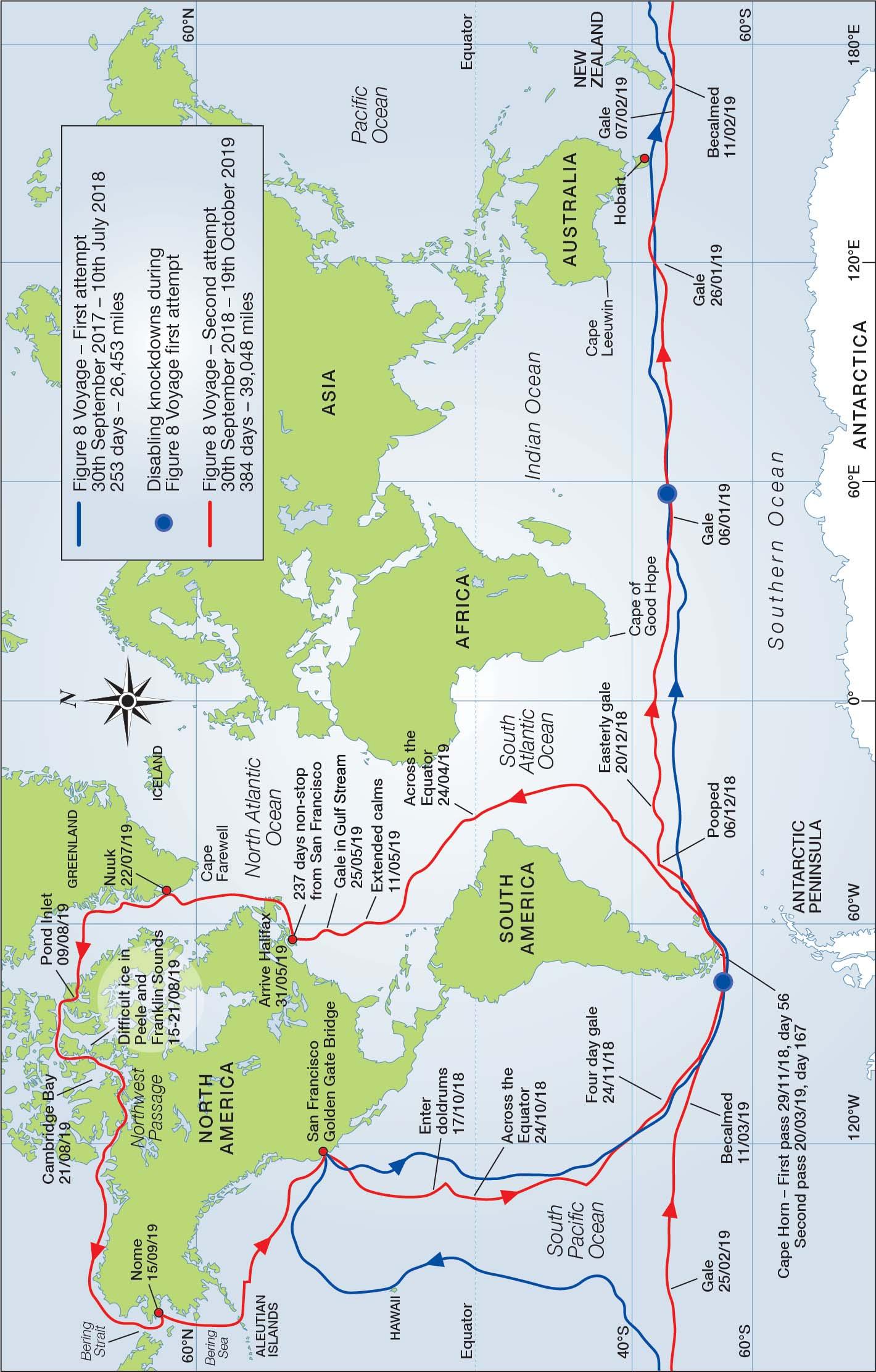
21 minute read
THE CRUX OF THE MATTER by Randall Reeves
(Randall’s account of the first part of his unique ‘Figure 8 Voyage’, for which he was awarded the 2019 Barton Cup, appeared in Flying Fish 2020/2 – see A Second Try at the South, also available on the OCC website at https://oceancruisingclub.org/Flying-Fish-Archive. More recently he also received the Cruising Club of America’s prestigious Blue Water Medal for 2020.
Mōli (whom Randall refers to as Mo) is a 45ft (13∙7m) aluminium sloop, built in 1989 and previously owned by OCC member Tony Gooch who made a non-stop solo circumnavigation with her in 2002/3. More of her history – and a stunning photograph – will be found on pages 106 and 107 of this issue.
Randall sent in daily posts from sea, including high-resolution photographs, and has since produced The Figure 8 Voyage, a picture book of images from some of the remotest places on the planet, which can be purchased from his website at www.figure8voyage.com. A more detailed book is planned.)
15th August 2019, Graham Harbour, Devon Island Compared to the roaring river that is the south, the north is a cathedral of quiet. From Mo’s Graham Harbour anchorage at 74°30’N 88°10’W there was such stillness that I could hear my ears ring and the low grumbling of a nearby growler as it jostled the rocky shore. Here, in late summer and yet at the beginning of the Northwest Passage, I would gnaw my fear for an evening while awaiting another discouraging ice report. The coming days would decide the success not just of this transit but of the entire Figure 8 Voyage, and the going did not look good.
Often during Mo’s Southern Ocean circuit I anticipated with pleasure the anticlimax to follow our second Cape Horn rounding. There, at 56°S, we would be released from the imperative to make easting – we

Randall poses for a selfie with a particularly attractive iceberg during his 2019 crossing of Baffin Bay
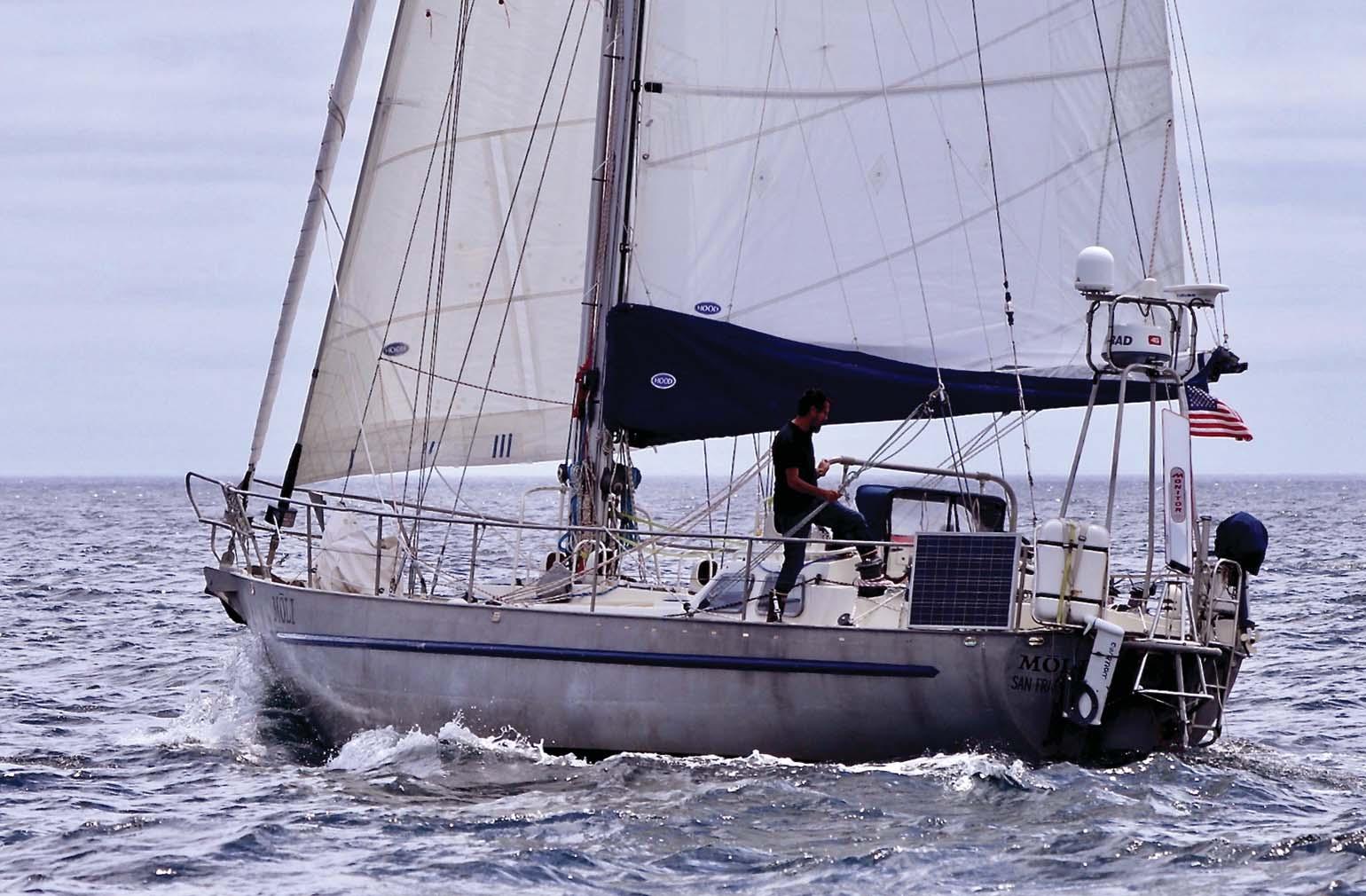
Departing Halifax on an easterly breeze. Photo Sebastiaan Ambtman
would climb into the hospitable Atlantic, into the unfaltering and floral trades requiring no hand on sheet or tiller nor overnight calls to reef. These would be fit refreshment, I thought, after our arduous time in the wilds down below.
And what we got on the advance toward Recife was warmth aplenty, but also a season surprisingly devoid of steady breezes and a sea clogged with sargassum weed. Where the south had promised, and usually delivered, a gale a week, now we were made to endure as many calms. By the time Mo drew level with Bermuda she found it difficult to run off even a hundred miles from one sweltering noon to the next. Ever so slowly the lengthy blue ribbon of Atlantic slipped by. Then, on 31st May 2019, the port of Halifax emerged from fog, and here we made our first stop on day 237 out of San Francisco.
This call, too, contained its surprises. For one, as I handed Mo’s lines to Wayne Blundell, dockmaster of the Royal Nova Scotia Yacht Squadron, the man handed back an envelope full of cash – an entry custom I’ve not found typical of foreign ports. “Sent ahead by your friends Tony and Connie,” he said, “so you can buy a round at the bar”. In Halifax we refitted over the course of a month. Items not even contemplated in the previous 31,000 sea miles – anchors, chain and windlass, autopilot, depth sounder, dinghy and outboard, the radar, the little red engine – were serviced, run hard, tested and tested again for the coming Arctic trial. And all the while the Canadian ice charts declared only Pas d’analyse (No analysis). Summer solstice had come and gone and still there was nothing to report.
Mo and I departed Halifax heading north on 2nd July for an uneventful run to St John’s. Here we were welcomed at the Royal Newfoundland Yacht Club pier by Port Captain Ted Laurentius, and many a passer-by remarked ‘Oh look, that’s Tony’s boat’*.
* Mōli sailed in high latitudes as Taonui when owned by OCC members Tony and Coryn Gooch, and is frequently recognised as ‘Tony’s boat’ in out-of-the-way places.
We departed on 15th July for a slow jog up the west coast of Greenland, more for the pleasure of it than to avoid the famous middle pack. There was no hurry. By this time, the reports showed that ice in Lancaster Sound had begun to flush, but it hadn’t shifted at all in Peel Sound or Prince Regent Inlet.
In Nuuk, with the help of local magistrate Jens Kjeldsen, I bought a rifle for defence against polar bears. To my amazement (as an American), the attendant handed over the firearm and shells with as much concern as if I were buying a quart of milk. Then I followed Jens to a birthday party for his Inuit wife. These two had just returned from a circumnavigation via the Northwest Passage. “My wife is the only Inuit to have sailed around the world,” said Jens. “She made all the papers”.
South of Disko Island, icebergs appeared. Distant white specks jutting above the blue plane grew to gothic spires or became tabular and sheer, and all calved brash that flowed away on the current like the tail of a comet. On 26th July we crossed the Arctic Circle in fog and calm airs. Near Sisimiut, a black ooze in the bilge revealed that Mo’s little red engine (a 48hp Bukh diesel) had burst an oil seal. Luckily, a replacement was found in the last-explored parts bin of the town’s snowmobile shop. Finally, in Sondre Upernavik we took on fuel by dinghy for the 400-mile crossing of Baffin Bay, filling all of Mo’s fourteen jerry cans for the first time.
The crossing was grey and flat and not much else. The approach to Pond Inlet on 9th August was ice free, as was Navy Board Inlet and the approach to Tay Bay two days later. Even the run up Lancaster Sound presented glassy, open water with but here and there a brilliant berg. Still, each report from Environment Canada showed persistent, close pack inside the passage. Only slowly was the Canadian archipelago Filling jerry cans at releasing her winter the town pier in Sondre wealth. Upernavik, Greenland I am often told by those in the know how much easier a Northwest Passage transit is today than it was in 1975 when Willy de Roos and his strong steel ketch Williwaw fought for every mile. Climate change has turned an ice passage into a lake passage with but an occasional frigid encounter, say these experts. There may be some truth in this, but it misses the point.
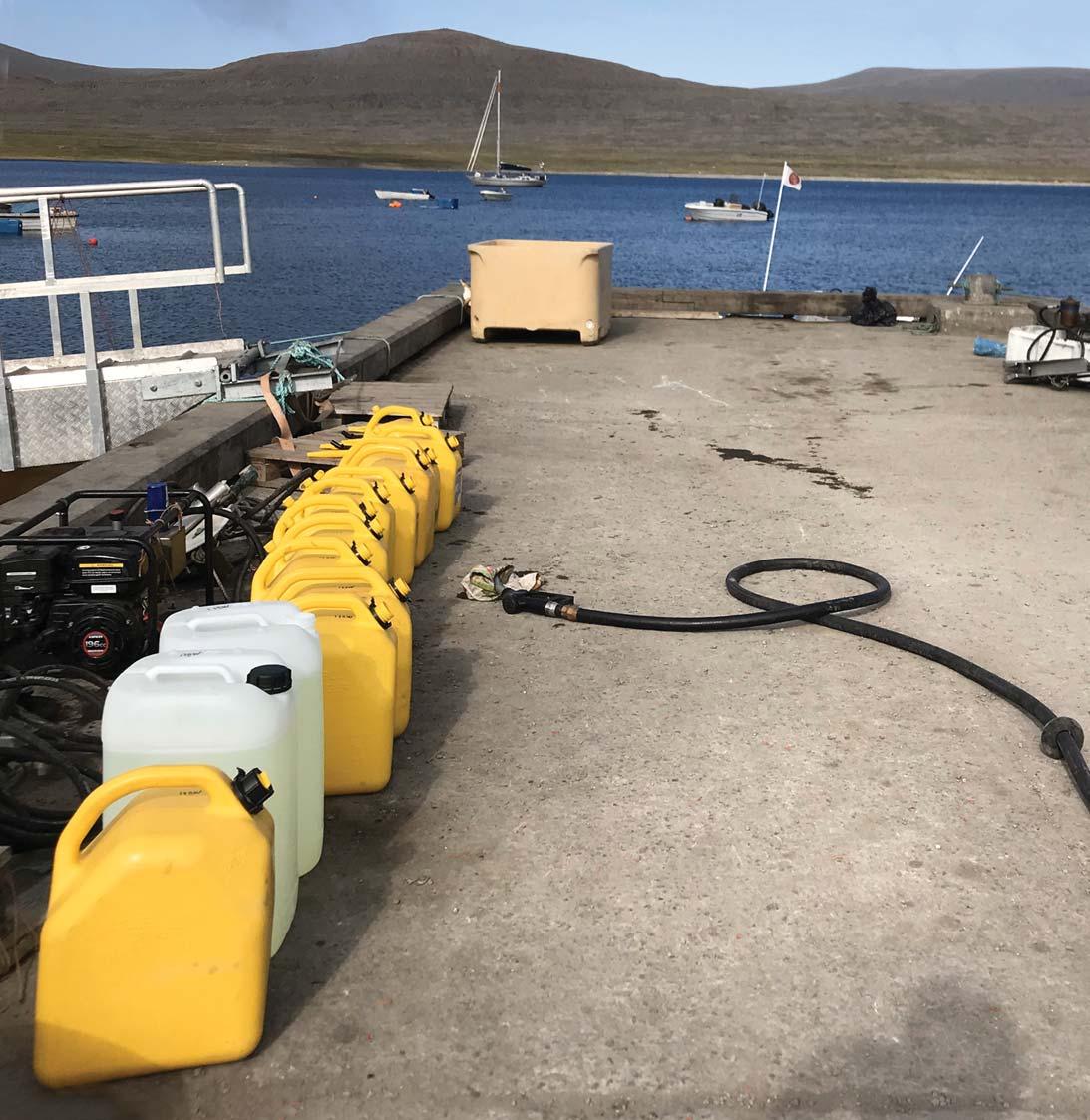
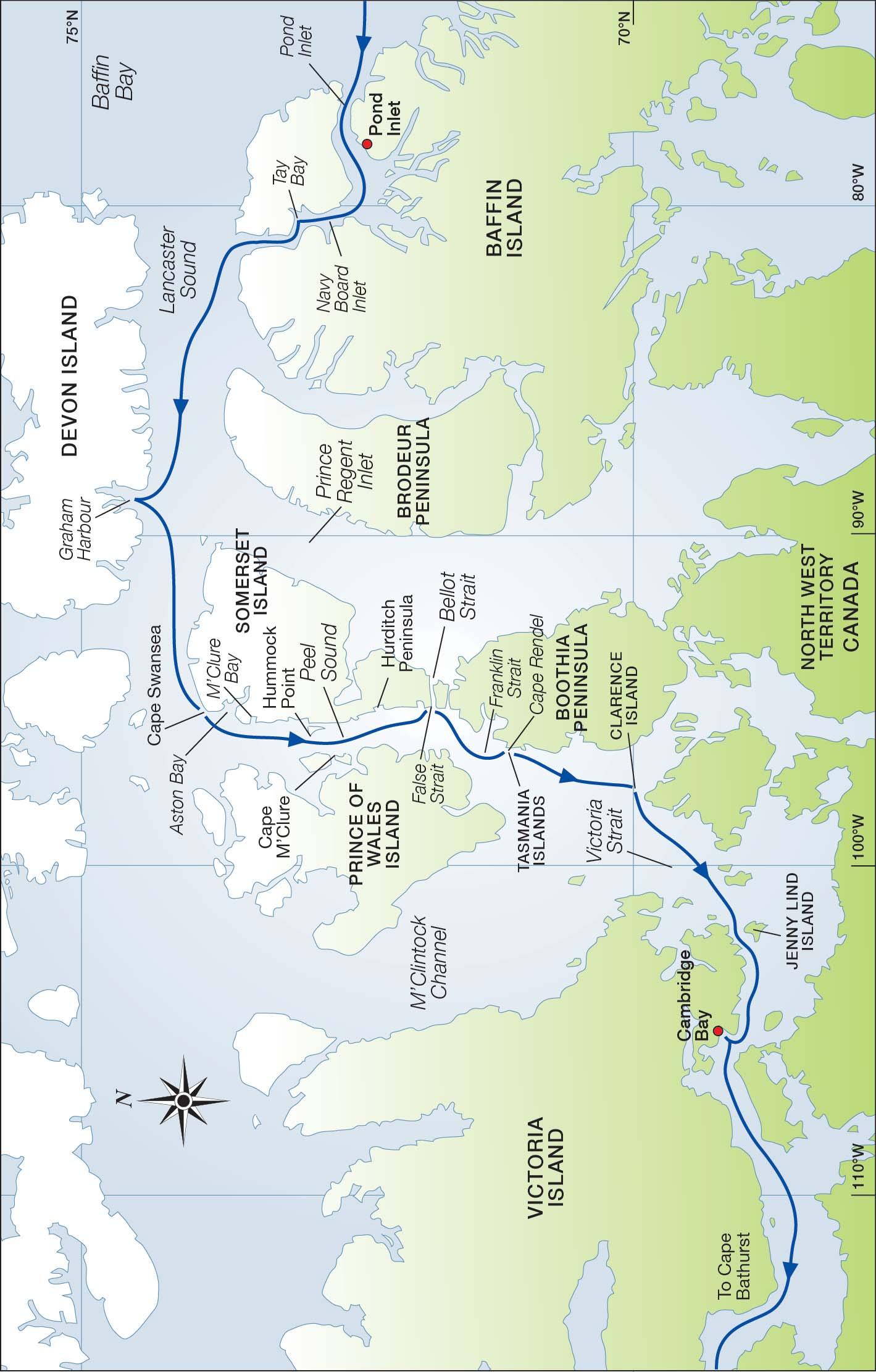

Bergs show as red targets on the radar
For a westbound yacht, the Northwest Passage – especially between an entrance at either Prince Regent Inlet or Peel Sound and the exit at Cape Bathurst – is a maze of sometimes narrow, often poorly-charted water. Here the pack can become trapped, swirling on local currents but unable to flush to sea – it must melt to clear the way. Moreover, though strong, Mo is not an icebreaker. Pack covering an area from one point to the next can stop her cold, and when that gate opens, allowing further progress into the maze, a gate ahead or astern may close and may remain so for the duration. The risk is of finding oneself deep inside enemy territory with no ability to advance or retreat and facing the prospect of a ten-month freeze.
Graham Harbour is eerie. The cove is small and depths are too deep with a bottom too rocky for good holding. The crowding mountains threaten williwaws and put the boat in a cold shade. Three times the anchor merely clanged across the bottom before catching by a fingernail. I set the drag alarm and prepared for a night of poor sleep. After dinner, I reached out to ice guide Victor Wejer for one final consultation. “Prince Regent Inlet remains impenetrable,” he responded, “absolutely no chance it or Bellot Strait will be available to you this year. Peel Sound is your only hope”.
Over the previous few days the pack had begun to move in Peel Sound, but this was meagre encouragement. The colour-coded charts from Environment Canada displayed long stretches of orange (indicating surface ice concentrations of 7–8/10ths) from its entrance all the way
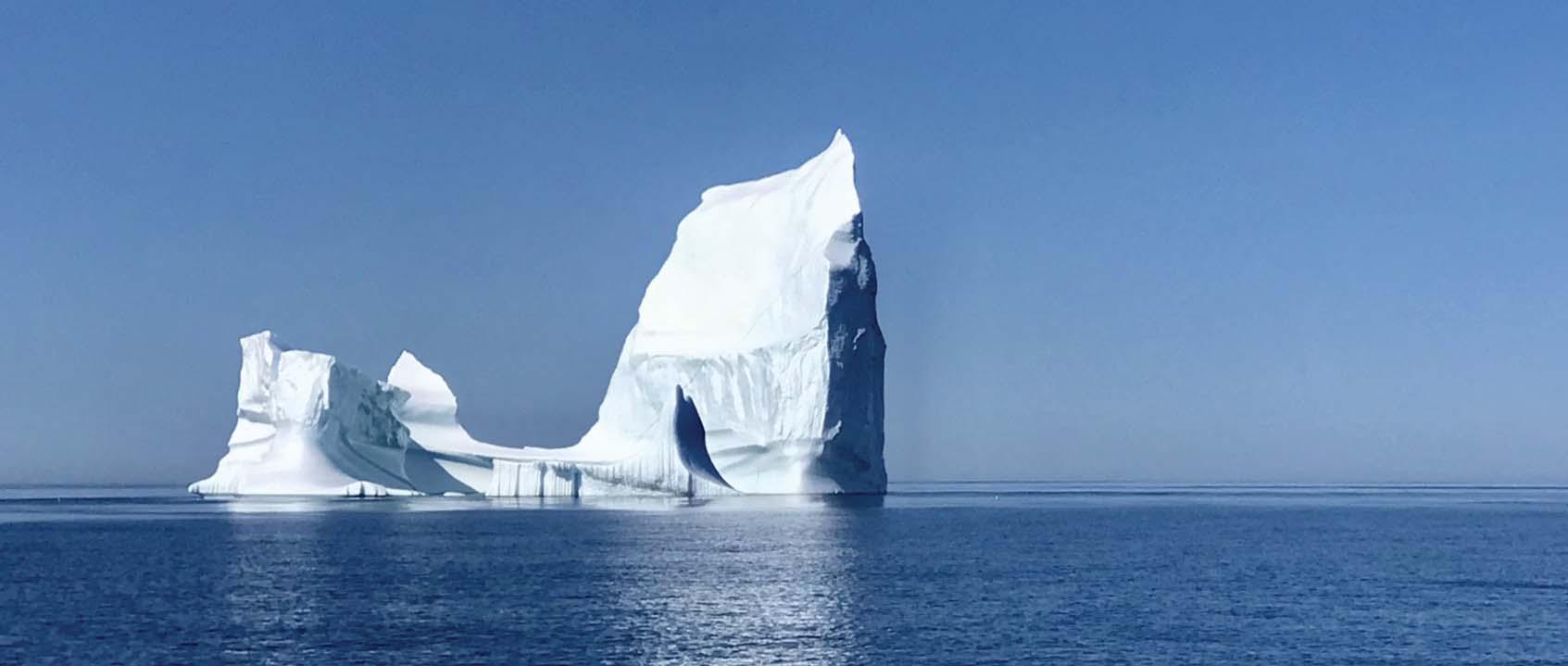
We sight our first big berg on the approach to Disko Bay
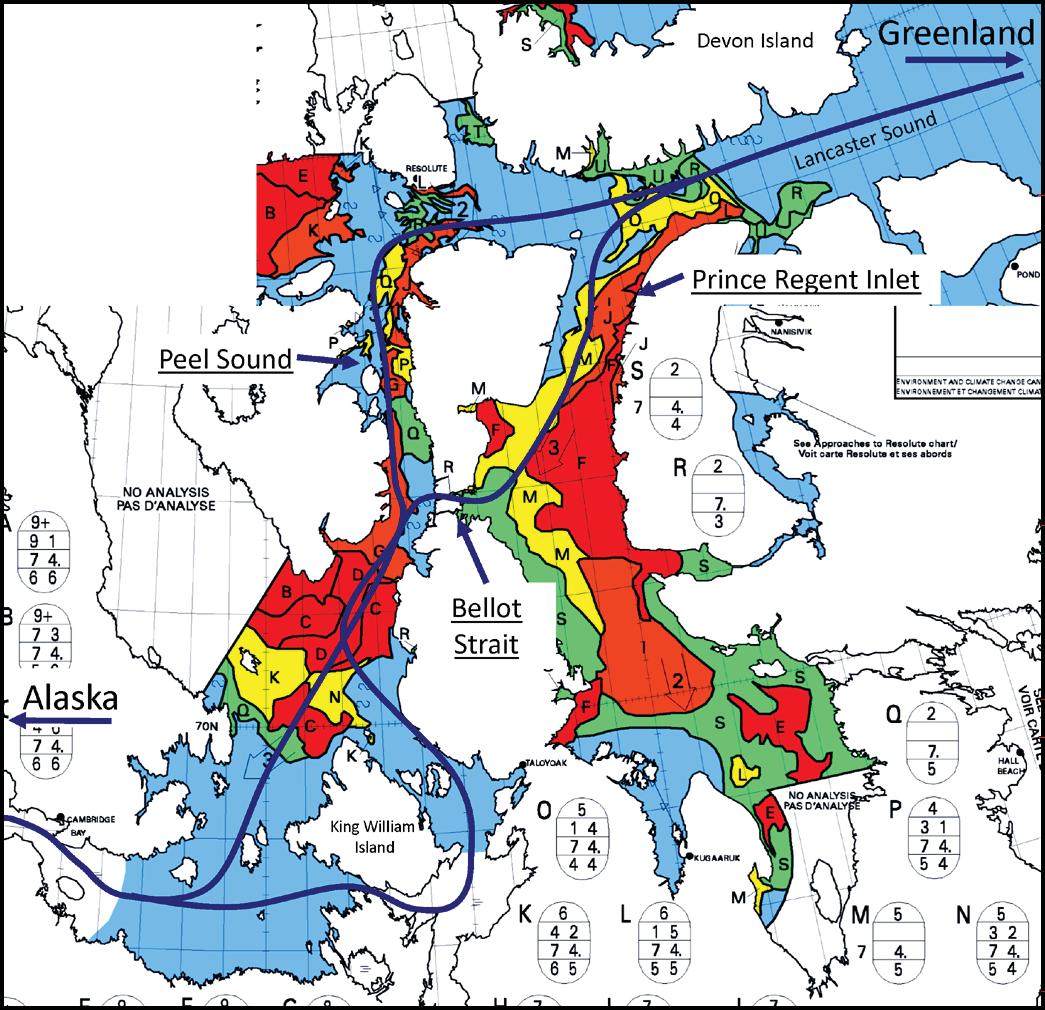
A chart from Environment Canada showing surface concentrations of ice between Lancaster Sound (NE) and Cambridge Bay (SW). Red areas indicate that 9–10/10ths of the surface is covered in ice, orange indicates 7–8/10ths coverage, yellow, 4–6/10ths, green 1–3/10ths and blue less than 1/10th. White areas indicate land or unmoving ice (thus ‘No analysis’) or open water. The blue line indicates possible routes through this section of the Northwest Passage
to Cape M’Clure. Below Franklin Strait great masses of ice flowed down from M’Clintock Channel, and here the chart remained resolutely red (indicating surface concentrations of 9–10/10ths ice). Worse, the 165 miles from the intersection of Lancaster and Peel to the first tenuous anchorage at False Strait provided no secure hiding places.
I knew from Victor that other yachts were having to battle in this section. Inook had punched south of Bellot Strait, friends on yellow-hulled Breskell were in Peel with Altego and Morgane nearby. These boats had crews who worked the ice from the bow with long poles, wedging through the pack, clawing for every inch. “Alioth is a day ahead of you and reports it took twelve hours to pass from Hummock Point to the Hurditch Peninsula”. I went to the chart and measured it off – 12 hours to make 40 miles. “This a difficult year,” wrote Victor. “Most sailboat crews fight tooth and ice pole to get through Peel. But there is no option. It is time to take your difficult bite”.
16th August, Lancaster Sound Mo departed Graham Harbour under power at 0400. Already the sun sat two hands above the horizon, warming the fluted cliffs of Devon Island as we emerged from the
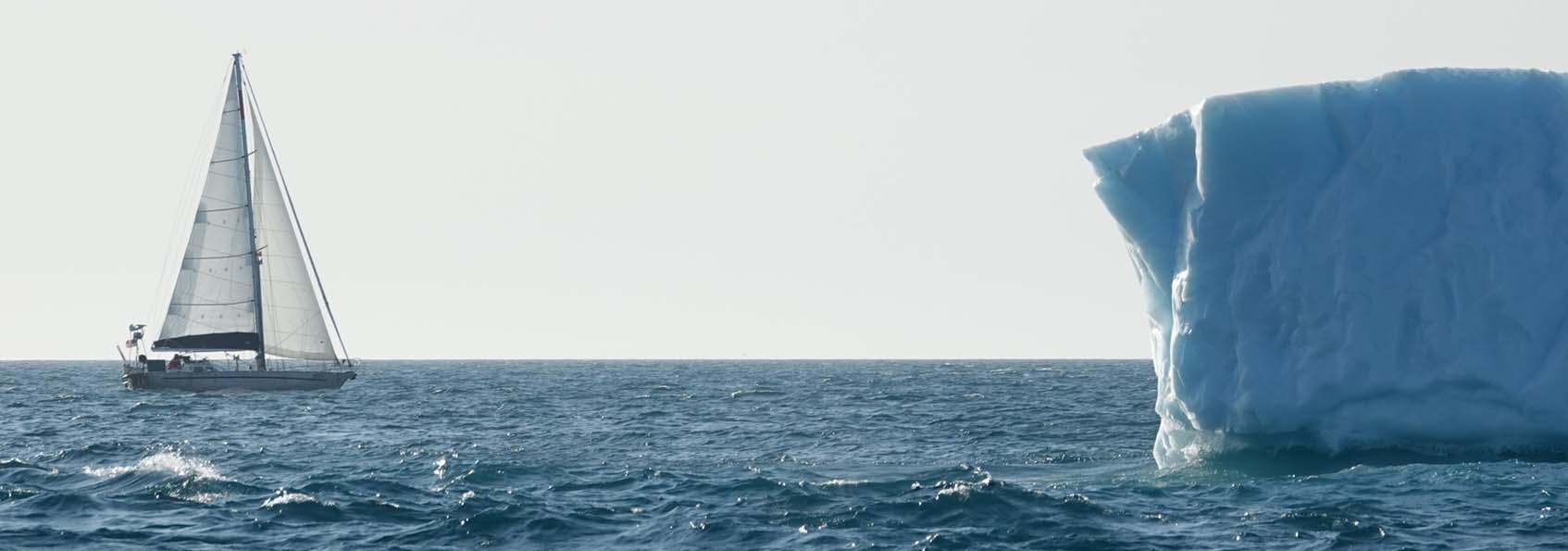
Mo about to pass to leeward of a big berg in Lancaster Sound. Photo Vincent Moeyersoms
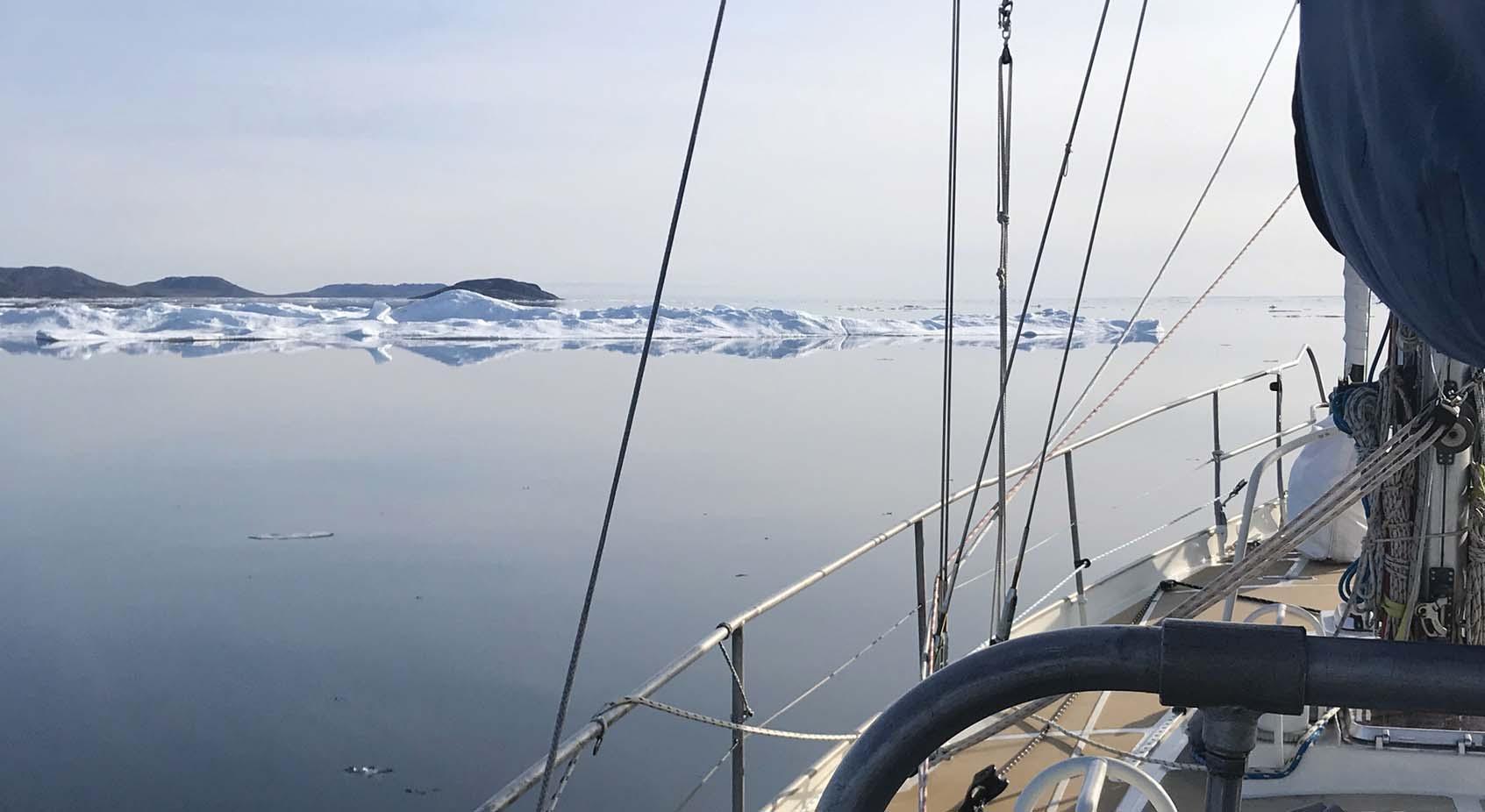
Flat calm and first ice at the head of Peel Sound
darkness of the anchorage. Not a breath of wind – the sea, a navy-blue mirror. I made our course west-southwest for the entrance to Peel Sound, distance 120 miles. All day as we crossed the fulmars flew the other way, out from the ice maze ahead, down Lancaster Sound, into Baffin Bay and south. The fall migration had begun. We were pushing against the stream.
By midnight the headlands of Prince of Wales Island had covered the sun. During our 20 hours from Graham Harbour at least one white chunk had always decorated the horizon, and now being off watch for more than 15 minutes was too long. Given the difficulties of the next leg, I decided to take one last, long sleep. Off Cape Swansea at the head of Peel Sound I hove to and shut down the engine. Mo drifted slowly northward. I crawled into my sleeping bag but I could not find sleep. Worry brought me on deck every hour. At 0400 I rose, made coffee and a hot breakfast. By 0500, we were underway again.
17th August, Peel Sound Clear and calm again. As we motored hour after hour, each notation in the wind column of the log read simply, zero. Bright sun, warm on face and hands, produced temperatures in the cockpit of 50°F (10°C). With no ice in sight I set about chores, topping off the fuel tanks from the jerry cans, lifting the hydrogenerator, and removing the windvane paddle from the transom. Neither would be needed for many days, and either could be fatally damaged by a nip from the ice.
By 1100 we had crossed Aston Bay in open water, but two hours later Mo moved through long, low plains of 2/10ths ice off M’Clure Bay. I disengaged the autopilot and took the tiller. Easy going. The ice was rotten – some pieces were so decayed that they appeared to be nothing more than floating snow, others had been eaten by the warmth into pale green and white mushrooms. I pushed Mo at full speed and kept an eye forward for more.
From abreast of Hummock Point I saw solid white on the horizon, which the day’s mirage transformed into the crest of a tsunami rolling towards us. Soon we moved through more ice than water, but with care and concentration I could always find a
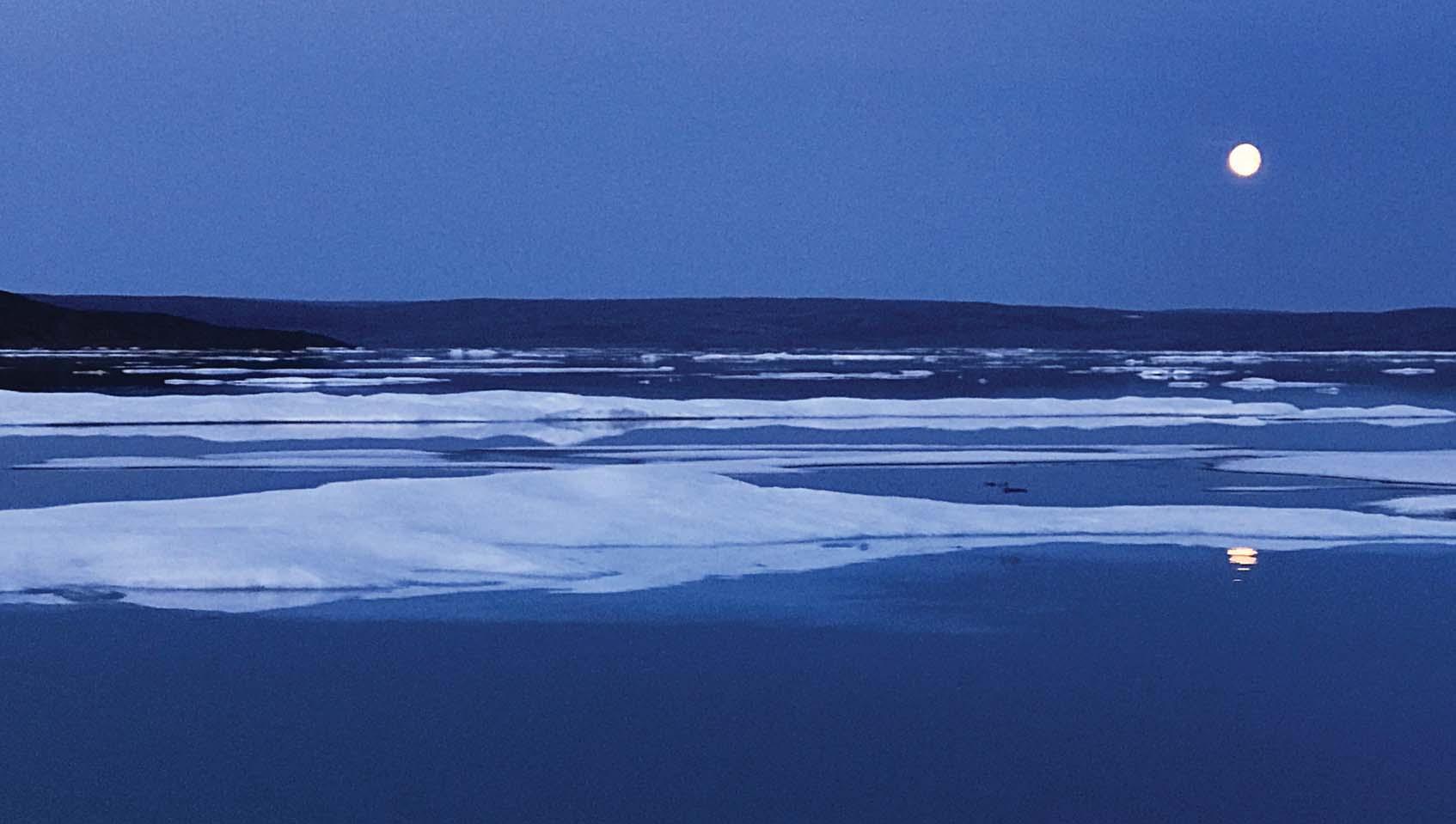
Midnight, deep within Peel Sound. The western sky remained orange, but in the east it was deep purple with a full moon over low hills
lane just when it was needed. Mo, a heavy bird, swooped and dodged through the floes while I exercised the tiller as if it were the handle of an oar. And it was exhilarating, the constant motion, the rapid decision-making. We could do this, I thought.
Only once did I screw up, and this by aiming to split two close floes – too late I saw the diagnostic light green water between them indicating their connection below the surface. Mo thunked quietly, then there was a clinking sound like ice cubes in a glass. Astern, the floes drifted apart.
Ice went thin, then thick, then thin again. Sometimes the way ahead seemed closed until we were right up to the pack edge, then I’d see a sliver of water. We’d follow slowly, feeling a route as much as seeing it. Then a pause. I’d climb to the spreaders searching the white for dark veins. Then onward and out. Heave to for a cup of coffee or can of soup. Then at it again. Hours passed, and I was still working the tiller.
By 2300 what had been heavy-going began to thin. The water was clear enough that my course changes were slight, mere nudges of the tiller between my legs with hands in pockets for warmth. I played the dangerous game ... how little could I change course, how close to the ice could I safely get? Only occasionally a miss, proof being a soft swooshing on the hull and a smudge of black bottom paint on the passing floe.
Midnight. The western sky remained orange, in the east it was deep purple with a full moon over low hills. The dusk made for difficult seeing, but here the floe was odds and ends. I had been hand-steering for 20 hours. Fatigue weighed on leaden eyes, my thighs were shaking.
Ahead at last was a long, dark opening as wide as the sound. Clear water. The faint white on the horizon must be a whole ten minutes distant. I flipped on the autopilot, dropped below, and set the alarm for a five-minute nap. I collapsed against a bulkhead, immediately asleep. On the fourth minute a heavy crashing sound. Mo shuddered as if hitting a wall and stopped dead. The engine ground right down. I leapt for the throttle and backed her off and then looked forward. Mo and an ice block the size of a car were drifting slowly apart.
By 0200 there were scattered floes but we were past the first plug. A sense of satisfaction, and still we motored south. Finally to the east I saw the expected cut in the land, False Strait, where we dropped anchor at 0600. We’d come 150 miles in 26 hours and were through Peel Sound.
18th August, Tasmania Islands At noon the next day the anchor came up clean, the tip shining bright – another rocky bottom. Over a quick morning coffee, I pulled an ice report and then also noticed a message from Alioth.
Hailing from Belgium, Alioth was a 55ft aluminium expedition sloop we’d met for the first time in Halifax. I’d gotten to know her crew of three – skipper Vincent Moeyersoms, with Olivier and Jean, brother and friend respectively, experienced sailors all. After a day of outfitting we would meet to compare notes over a beer, and I came to admire Vincent’s thoughtfulness and his careful preparation. Still, one cannot anticipate every eventuality. This morning’s message said that Alioth’s gearbox had failed (who carries a spare gearbox?). Now she was without propulsion in 5/10ths ice south of the Tasmania Islands, some 75 miles from our position. She’d have to sail the 250 miles to the next village, Cambridge Bay, for repairs and was asking if we would join her as consort. We departed immediately.
As Mo steamed southwest I could see ice issuing from mile-wide Bellot Strait in a continuous sheet. How fortunate we were to be heading away from it, how unfortunate that within ten minutes we had entered an obliterating fog. I reduced speed to 4 knots and began to pick my way through loose floes. It was easy enough going, but I had no idea what lay ahead nor if my lane would remain clear. The cold was nipping hard. My
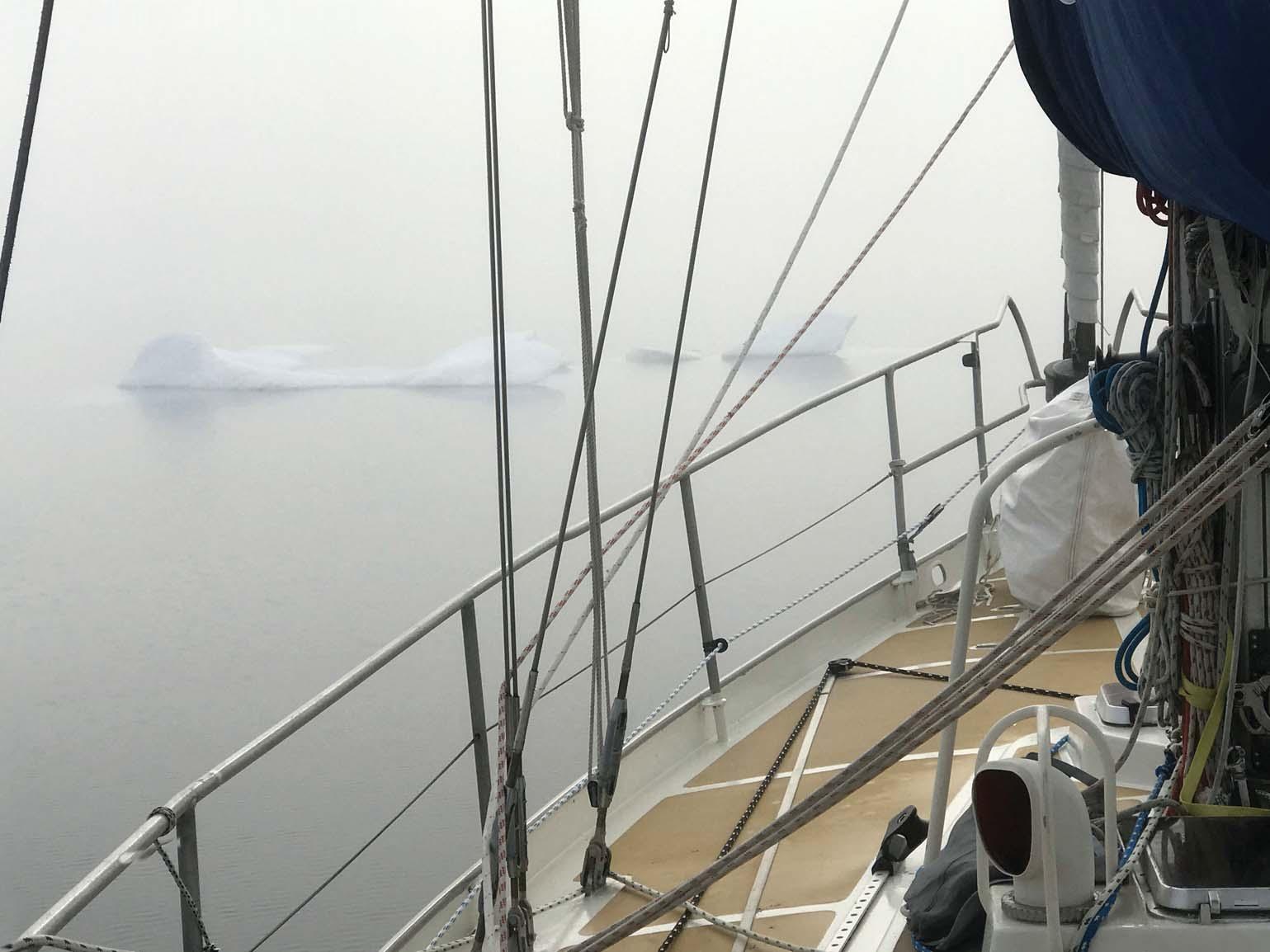
Growlers coming out of a thick fog south of Bellot Strait

Cold and tired after hours of handsteering en route to the Tasmania Islands
hands were in a triple-layer of fleece and leather mittens, but the mitt on the tiller felt thin as paper and that hand soon ached, and my toes were numb even after stamping in place. And so painfully slow was our progress! I began counting off the seconds between when ice became visible and when it passed abeam. At first the count was five. When the fog dissipated enough that I could count to ten, I put Mo at full speed.
We approached the Tasmania Islands in late evening, and here the fog lifted and the ice thinned to mostly open water. I knew I needed a short sleep before encountering the unknown with Alioth so decided to risk the pass between the easternmost Tasmania island and the mainland. Depths were not marked on my chart, but I had a faint recollection of Bob Shepton having been through here in Dodo’s Delight, and a divot in the coast catty-corner* from Cape Rendel looked like a promising shortterm anchorage. It was nearing midnight when we made the entrance and here we passed a solid line of growlers grinding together where tidal streams met. Inside the pass the current pushed against Mo and our progress slowed dramatically. Worse, the cut was full of brash and scattered floe. With such a current the anchorage I’d hoped for would be too easily swept – there would be no stopping after all. The bottom continued to be uniformly deep mid-channel, but ice kept me at the tiller. In the darkness, fatigue and cold bore down with intensity and were moderated only by the sense of risk and the need to keep moving.
By 0400 we had exited the pass and were back into the relative safety of the strait. Exhausted and shivering I hove to, shut down the engine, heated a can of soup and went straight to my bunk. Two hours later I woke to a heavy thudding against the hull. The day was bright, the sea a solid white all around, and Mo lay gently heaving in close pack. From the pilot house we seemed penned in, but from a perch on the gooseneck winch I found the floe looked loose enough that we could make slow way to the southeast. Alioth * diagonally opposite
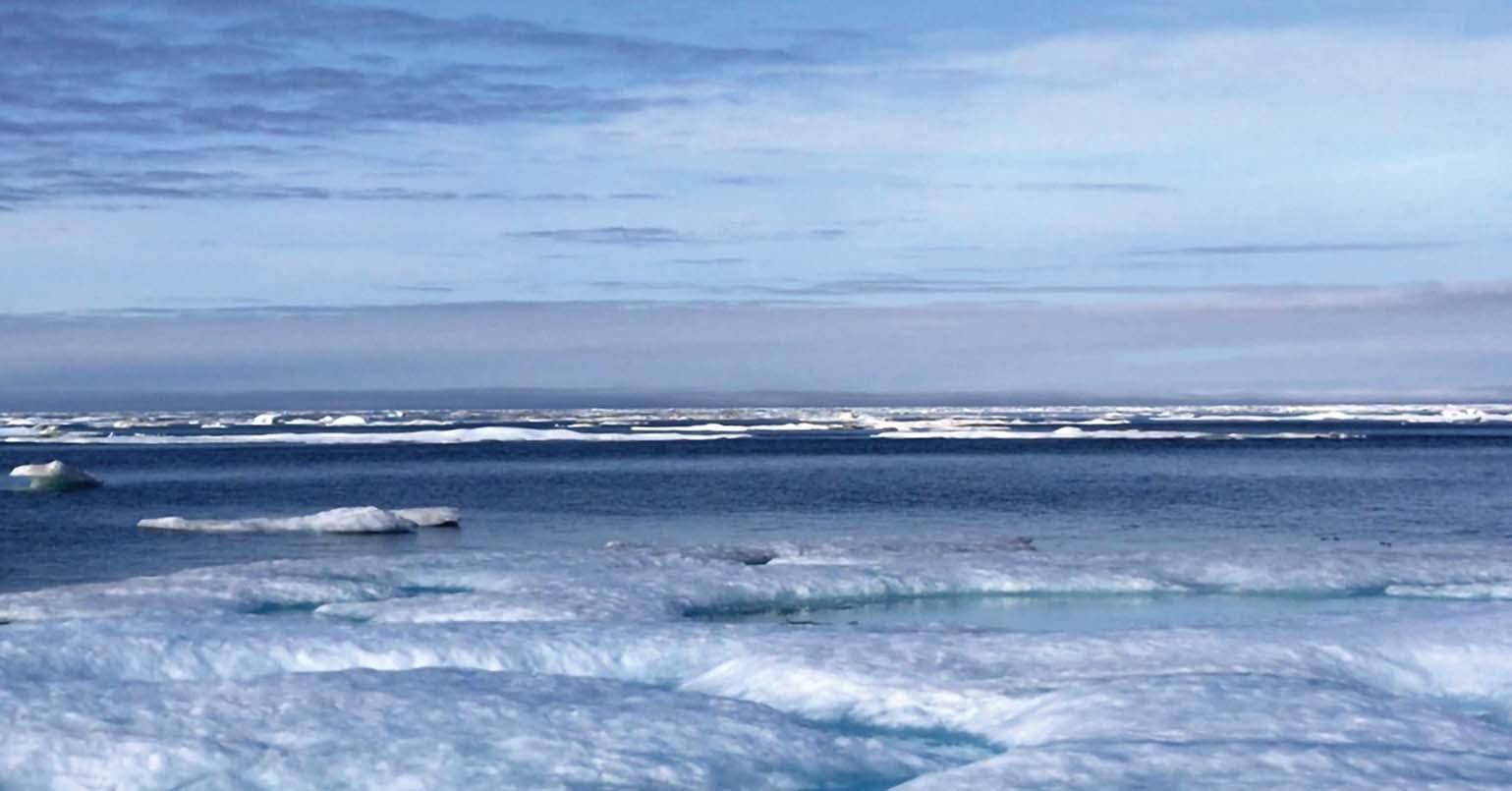
Difficult ice south of the Tasmania Islands
lay to the southwest at 70°51’N 97°19’W, half a day away where, according to Vincent, she was jogging back and forth under mainsail in the gut of a large opening. Vincent reported solid pack to his north, east, and west but that he could see what appeared to be a clean lane due south. That was good news indeed, but could it last?
By 1400 I’d worked below a solid line of pack separating our two vessels and was able to swing due west toward Alioth’s position. An hour later her sleek grey hull came out of the mist where she was hove-to in a cove of blue surrounded by sparkling, icy shores.
“Nice to see a friend,” remarked Vincent over the VHF, “our lane seems to be holding, and there is a north wind”. Alioth spread her wings immediately and we began to make our cautious way. Sometimes our lane would tighten, at others it would divide, and then Vincent and I would study what we could see in binoculars and negotiate over VHF which path we thought best. Each decision, so made, paid off. Three hours later the
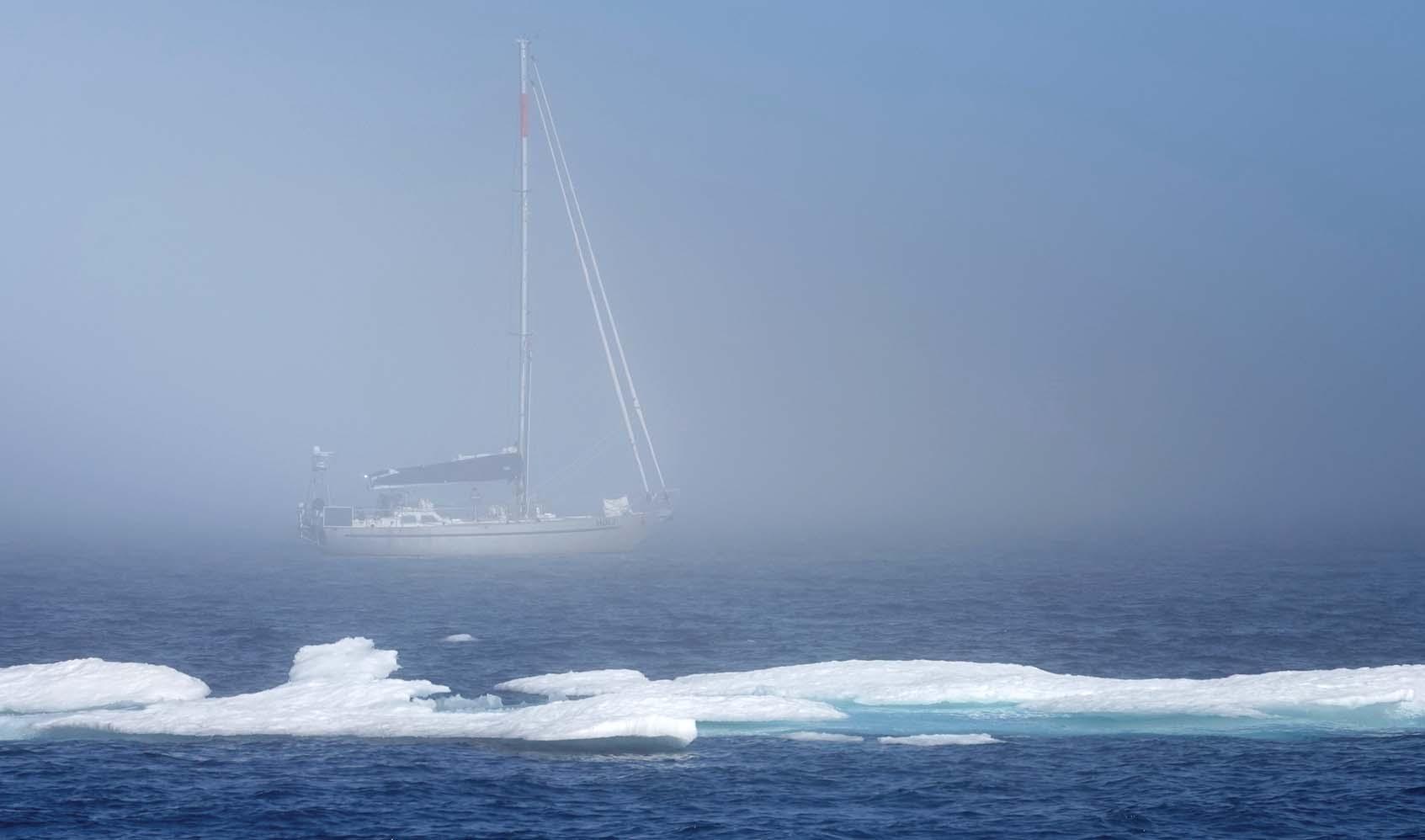
Mo as (just) seen from Alioth at our rendezvous south of the Tasmania Islands. Photo Vincent Moeyersoms

Alioth spreads her wings and we begin to make our way out of the ice
lane became so wide and straight it was as if Moses had parted a sea of white just for us. Then suddenly the ice receded altogether. We were below the second plug. Alioth made a close approach to Mo and we four cheered our good fortune.
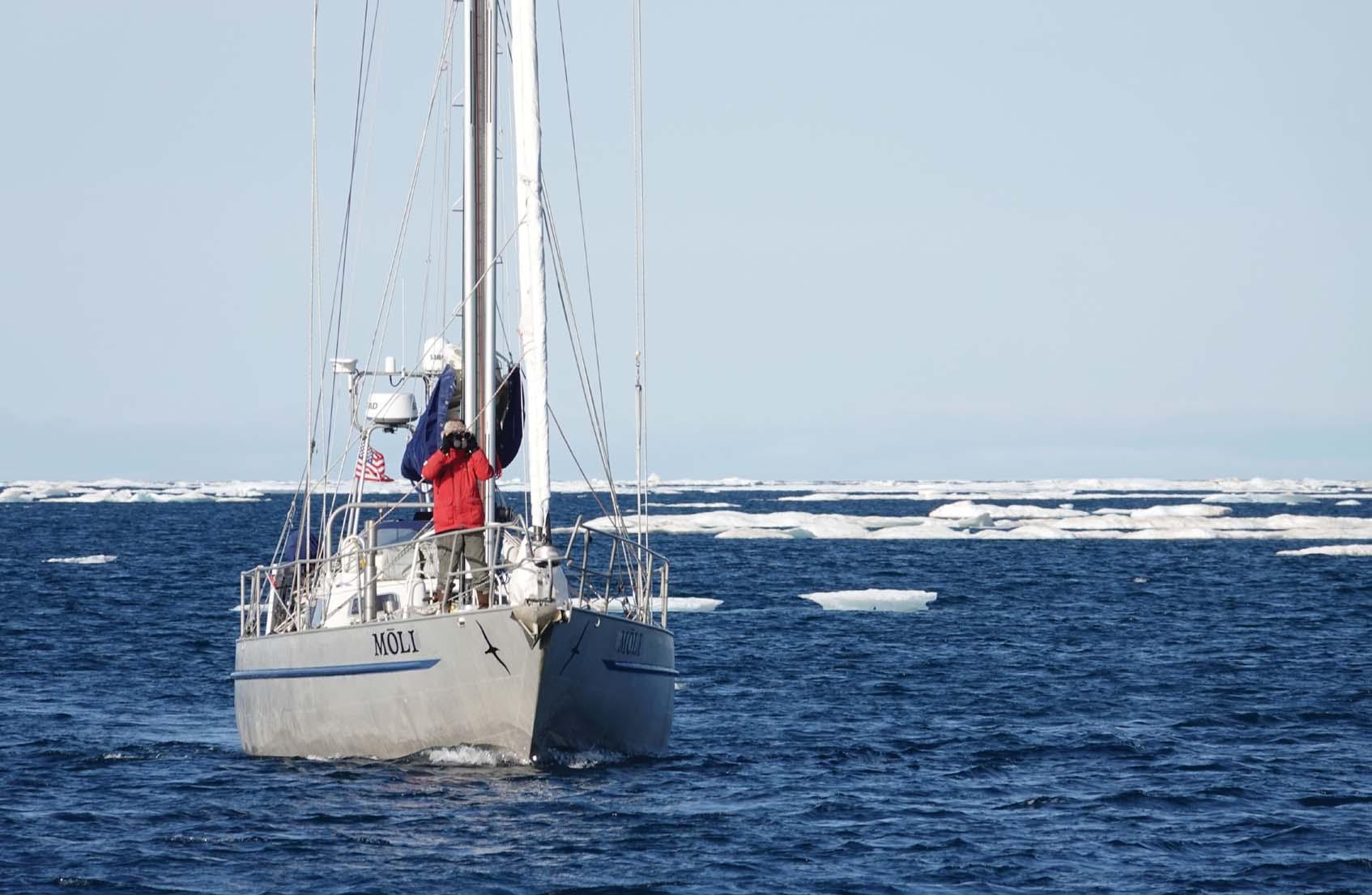
Searching for leads ahead with binoculars. Photo Vincent Moeyersoms

Below the second plug. Alioth makes a close approach to Mo and we all cheer our good fortune
We knew M’Clintock had pushed its pack well out into our preferred route, so we continued south until nearly aground on Clarence Island. Then we wore toward Victoria Strait in open water. Overnight our two vessels sailed in company in a beautiful following wind, around midnight Alioth taking the lead and keeping watch while I rested, promising to wake me on VHF if she spied obstructions ahead. Twice the VHF barked, “Mōli, wake up. Growler to port, do you see it?”.
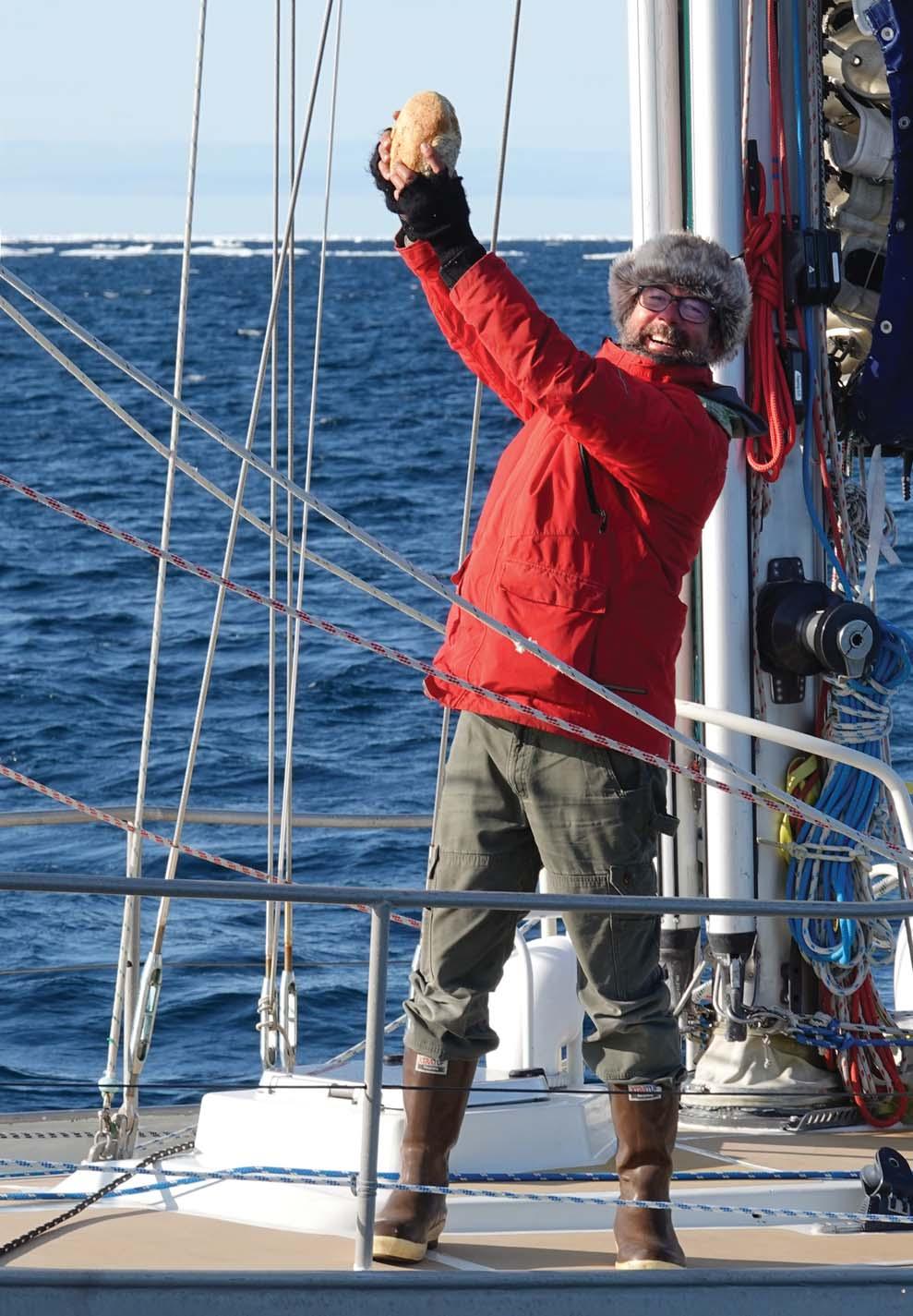
As Alioth swung by, Olivier tossed over a treasure – a loaf of freshly baked bread, which I was happy I caught without mishap and happier still to eat immediately with butter and jam.
Photo Vincent Moeyersoms
In the Arctic a sailing wind is rare and short-lived. Thus the next day came on grey, the sea greasy smooth, and with it arose a new problem. We were becalmed 100 miles from the shelter of Cambridge Bay, and though this presented no serious difficulties for the moment, the forecast was for an intense westerly gale to sweep our quadrant two days hence. Our position well north of Jenny Lind Island provided no room for running off or lying to a drogue in a blow that would work to push us back onto the ice we had just escaped.
I offered to take Alioth in tow, but Vincent refused. He didn’t wish to risk another man’s engine – and by extension, a successful passage out of the Arctic that season – just for the sake of his own. He countered that Mo should proceed to safety without Alioth, a suggestion I found equally unsatisfactory. Having achieved stalemate, we drifted in company most of the day, taking now and again a little breeze for a mile or two and until the evening forecast insisted we acknowledge the coming danger.
Mo pulled alongside Alioth in the twilight. Vincent lifted over a yoke and towline which I took and secured. I throttled up the little red engine, the line came taut and the two vessels were underway at 4 knots for Cambridge Bay. All night we motored, and into the next day. Gradually the sky lowered and grew threatening, but still there was no wind. In the late evening we entered the long channel to Cambridge Bay. Then we were inside and steaming up the welcome confines of the West Arm. At 2300 on 21st August I cut Alioth loose over her chosen spot and her anchor splashed down. I moved further up the bay and let go Mo’s anchor in 35ft (11m).
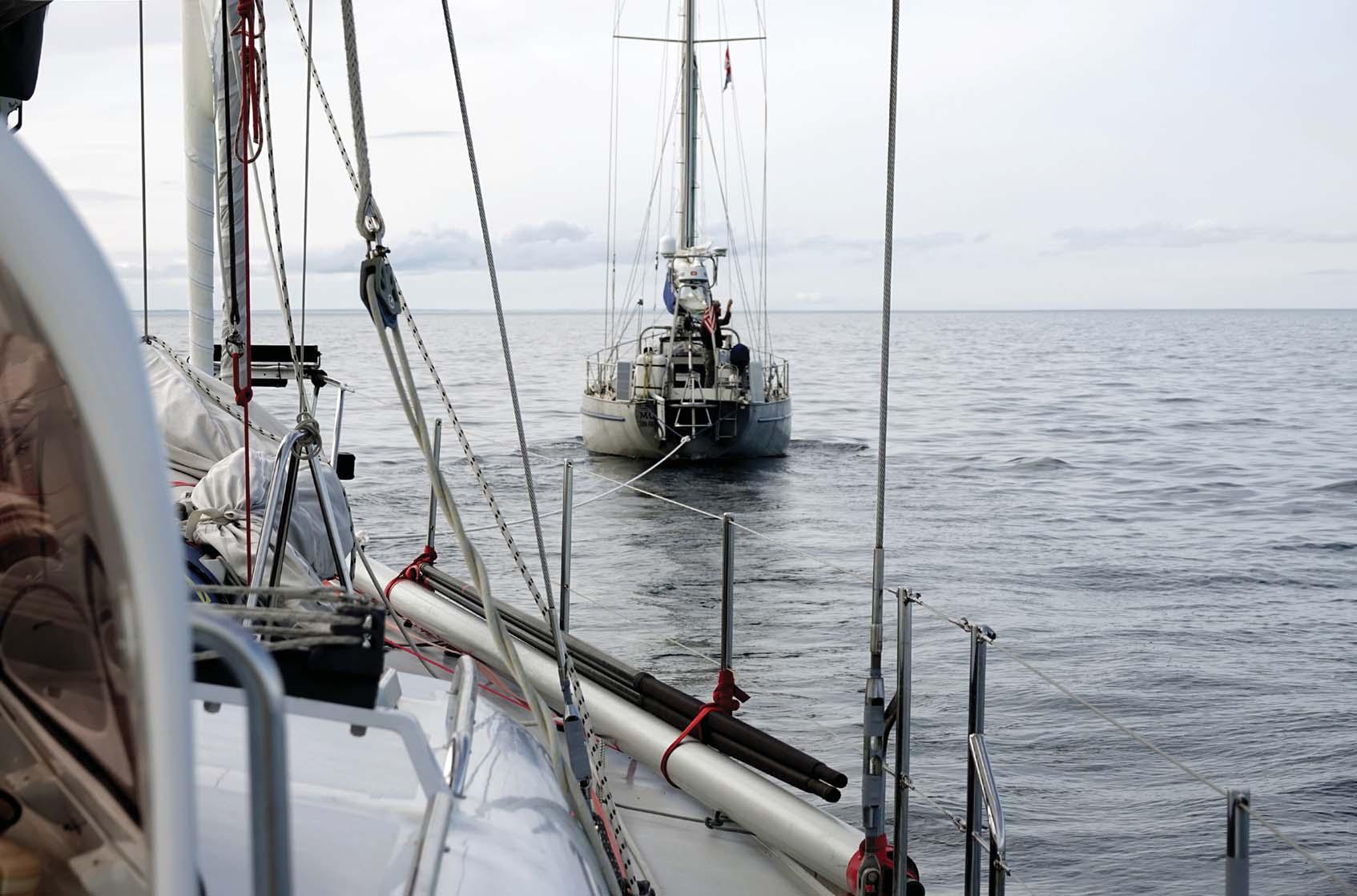
Mo took Alioth in tow to ensure we both achieved the safety of Cambridge Bay ahead of the coming low. Photo Vincent Moeyersoms

Happy sailors in Cambridge Bay. Left to right: Olivier, Jean, Pablo of Mandragore, Vincent and Randall.
Photo Olivier Moeyersoms
22nd August, Cambridge Bay In the night the gale came on as foretold. From my bunk I could hear the rigging roar as it had not done since the Falklands. Mo started at her snubber, but the holding here was ancient mud and her anchor lay buried far, far to windward. I eased deeper into the down of the bag and fell asleep listening to the blow.
A few days later Mo and I left Alioth in Cambridge Bay to await spare parts and at Cape Bathurst we departed the ice as well. On 12th September we crossed the Arctic Circle headed south. We stopped in Nome, Alaska the next day, made Dutch Harbor
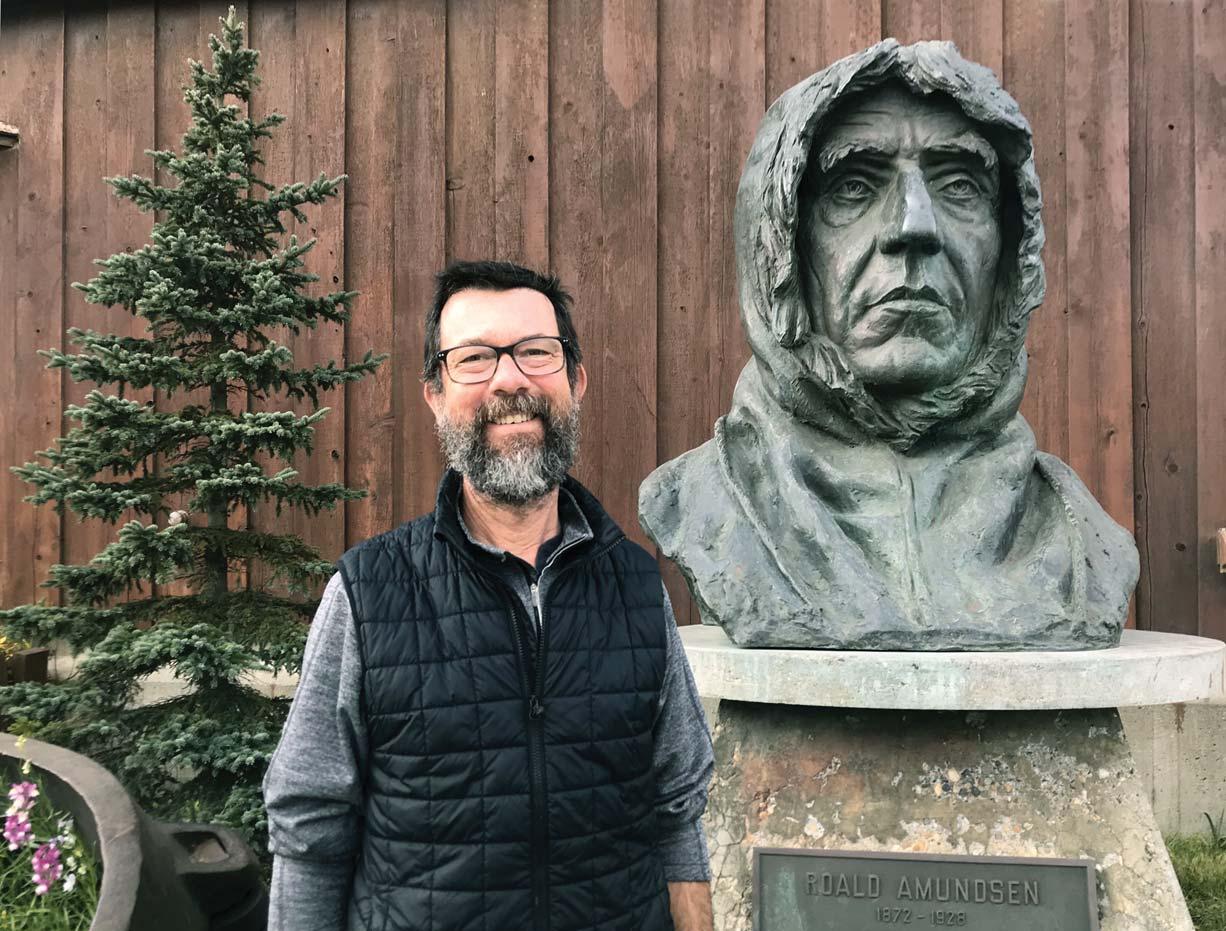
Randall alongside Roald Amundsen’s statue in Nome. Amundsen led the first successful transit of the Northwest Passage in 1903–6
on 20th September, and returned to our home port of San Francisco on 19th October 2019, completing the Figure 8 Voyage in 384 days.
Epilogue
I am often asked which was more difficult, the circuit of the Southern Ocean or the Northwest Passage transit. One thing that made the Figure 8 Voyage unique was that the demands of these two historic routes were so different – big wind, big seas in the open waters of the south, close quarters and pack ice in the north. In retrospect, I think the south was harder but only because it was longer. From her first pass under Cape Horn to her second, Mo sailed over 15,000 miles in 110 days, mostly at 47°S and taking, on average, a gale a week. Those conditions are very hard on both boat and crew. In the north, the demands shift from non-stop sailing to mostly motoring and frequent stops, but though the endeavour feels no easier, the summer window is very brief and the distances are shorter. Mo made her 5500 mile Northwest Passage transit in 48 days. Both routes are no-sleep enterprises for the singlehander and both, in their different ways, are glorious grinds.

Gjoa (now Mōli) over-wintering in Cambridge Bay during her 2014/15 Northwest Passage transit – see above.
Photo Denise LeBleu










